 |
 |
 |
| |
Perceptions of Care by HIV-Infected Women of Color in the United States
|
| |
| |
Reported by Jules Levin
ICAAC/IDSA Oct 28 2008 Wash DC
Sally Hodder,1 Judith Aberg,2 Judith Feinberg,3 Dawn Averitt Bridge,4 Staats Abrams,5 Stephen P Storfer,6 Kathleen Squires7
1University of Medicine and Dentistry of New Jersey, Newark, NJ; 2New York University, New York, NY; 3University of Cincinnati, Cincinnati, OH; 4The Well Project, Atlanta, GA; 5GfK Roper Public Affairs & Media, New York, NY;
6Boehringer Ingelheim Pharmaceuticals, Inc, Ridgefield, CT; 7Thomas Jefferson University, Philadelphia, PA
CONCLUSIONS
This study suggests that many African American and Hispanic women feel that their ethnicity, culture, or language impacted the care they received.
The results of this study suggest that many HIV-infected women change health care providers due to suboptimal communication.
The results of this survey indicate a need for heightened awareness of ethnic and cultural issues that influence a patient's interaction with health care providers and satisfaction with her medical care.
INTRODUCTION
New epidemiologic data suggest that there are now an estimated 400,000 women in the United States living with HIV/AIDS,1 with approximately 15,000 women newly infected annually.2
In 2006, women made up an estimated 27% of adults and adolescents with AIDS in the United States.3
African American and Hispanic women in the United States are disproportionately infected with HIV. 79% of newly identified HIV/AIDS cases in US women occur in African American and Hispanic women; however, African American and Hispanic women constitute 24% of the US female population.3
It is therefore important to understand specific issues relevant to the care of women living with HIV.
The purpose of the Women Living Positive survey was to assess health and communication needs of HIVinfected women.
METHODS
The Women Living Positive survey was a telephone-based survey designed for HIV-infected women who had been receiving antiretroviral therapy for 3 or more years.
Flyers advertising the survey were placed at a national network of AIDS counseling centers in the United States, directing those interested in participating to call an 800 number.
The 15-minute telephone survey consisted of a series of eligibility questions plus 45 questions designed to effectively detail the patient's relationship with HIV health care providers, treatment priorities, and pregnancy and HIV understanding, along with emotional aspects of living with HIV, including pregnancy and family planning issues.
Respondents were anonymously interviewed by telephone from December 21, 2006 through March 14, 2007; interviews were conducted in both English and Spanish.
Survey participants were compensated $25 for their time.
The survey was conducted by GfK Roper Public Affairs, a public opinion polling firm, and funded by Boehringer Ingelheim Pharmaceuticals, Inc. The Well Project, a nonprofit organization focusing on women and HIV, had input into survey questions.
RESULTS
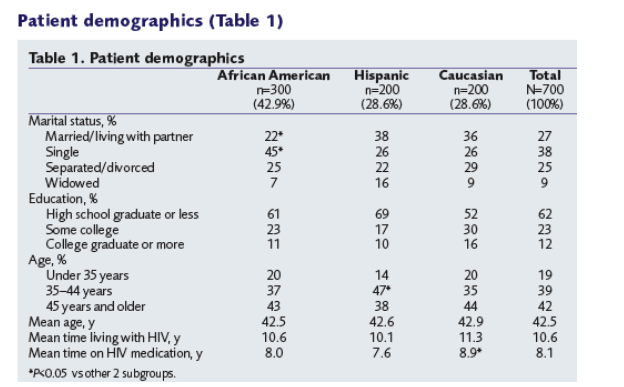
A total of 700 HIV-infected women participated in the survey. Of the participants, 16% were from the western United States, 21% were from the Midwest, 33% were from the South, and 30% were from the Northeast. 39% of respondents had children; more Hispanic (40%) and African American (41%) women had children
compared with Caucasian women (30%; P<0.05).
The study participants were aware of their HIV diagnosis for a mean duration of more than 10 years and had been taking antiretroviral agents for a mean of 8.1 years.
Relationship with HIV health care provider
While many women indicated that they felt comfortable talking to their HIV health care provider about their emotional needs related to HIV, in response to the question: "To what extent, if at all, do you feel that your culture, ethnicity, or language impacts the care you receive?", more than half of women (59%; 414 of 700) felt that their culture, ethnicity, or language impacted the care they received.
Hispanic and African American women were more likely than Caucasian women to feel that their culture, ethnicity, or language impacted the care they received overall (70% and 61% vs 37% respectively; P<0.05; answering either "a lot" or "a little" to the above question) (Figure 1A).
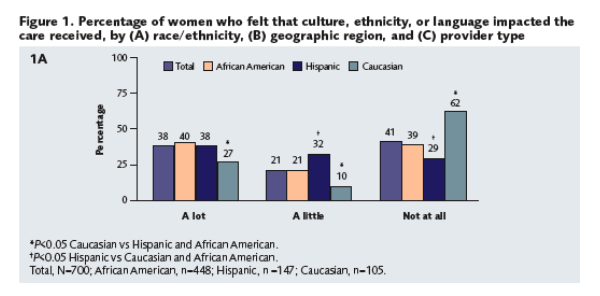
HIV-infected women in the South were more likely than those living in the West or Northeast to feel that their culture, ethnicity, or language impacted their care (67% vs 46% and 53% respectively; P<0.05; answering either "a lot" or "a little" to the above question) (Figure 1B).

Women seeing a family physician/general practitioner were more likely than those seeing an infectious disease specialist or other type of provider (nurse practitioner, physician's assistant, and physician other than infectious disease specialist/family physician/general practitioner) to feel that their culture, ethnicity, or language impacted their care (76% vs 53% and 49% respectively; P<0.05; answering either "a lot" or "a little" to the above question) (Figure 1C).
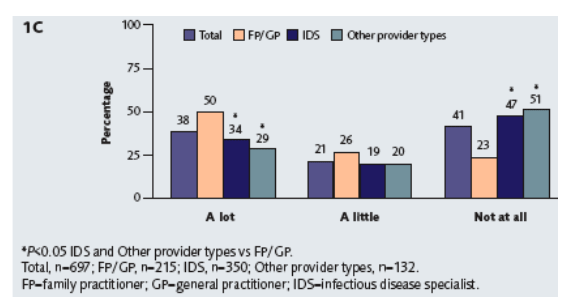
59% of women reported that their culture, ethnicity, or language impacts overall care. This survey found that 62% (433 of 700) of women changed their health care provider while being treated for HIV. Of these women, 44% (191 of 433) indicated that they made a change because of insufficient medical/emotional care.
43% of women (185 of 433) changed providers due to inadequate communication. Almost half (47%, 131 of 280) of African American women indicated they switched providers because of communication issues versus 33% (22 of 66) of Caucasian women (P< 0.05) (Figure 2A).
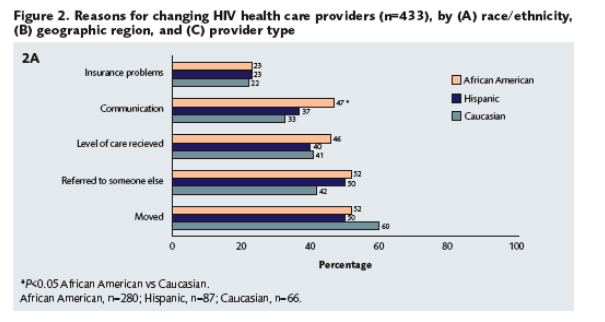
Women living in the South were more likely to have switched providers because of communication issues or the level of care they were receiving than women living in other areas of the country (Figure 2B).
Women currently seeing a nurse practitioner, physician assistant, or physician other than family physician/general practitioner/infectious disease specialist were more likely than those seeing a family physician/general practitioner or infectious disease specialist to have made a previous change of provider due to communication difficulties (51% vs 45% vs 38% respectively) or because they were referred to someone else (63% vs 42% vs 50%; P< 0.05) (Figure 2C).
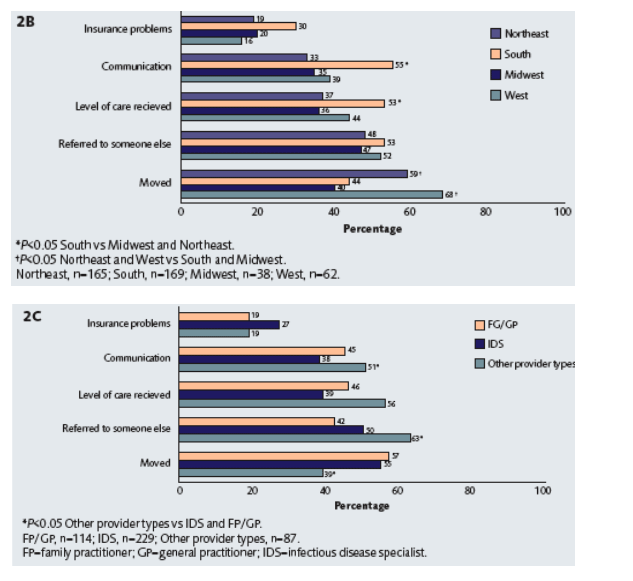
|
| |
|
 |
 |
|
|